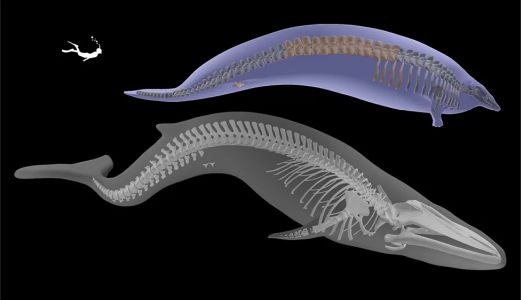 A recent study published in the journal Nature describes an extinct whale, Perucetus colossus, discovered in the desert in southern Peru, that rivals the blue whale in weight, if not necessarily in length. The Perucetus colossus was a basilosaurid whale from the middle Eocene epoch of about 39 million years ago.
A recent study published in the journal Nature describes an extinct whale, Perucetus colossus, discovered in the desert in southern Peru, that rivals the blue whale in weight, if not necessarily in length. The Perucetus colossus was a basilosaurid whale from the middle Eocene epoch of about 39 million years ago.
“The fossils were actually discovered 13 years ago, but their size and shape meant it took three years just to get them to Lima (the capital of Peru), where they’ve been studied ever since,” said Dr. Eli Amson, a co-worker on the discovery team led by paleontologist Dr. Mario Urbina, as reported by the BBC.
Eighteen bones were recovered from the marine mammal, including 13 vertebrae, four ribs, and part of a hip bone.
The bones were extremely dense, an adaptation that would have given this large whale the necessary buoyancy control when foraging in shallow waters. Similar bone features are seen for example in modern-day manatees, or sea cows, which also inhabit coastal zones in certain parts of the world.
Each vertebra weighs over 100kg, which is just completely mind-blowing,” said co-worker Dr. Rebecca Bennion from the Royal Belgian Institute of Natural Sciences in Brussels.
It is predicted Perucetus would have been about 17-20m in length, which is not exceptional. But its bone mass alone would have been somewhere between 5.3 and 7.6 tonnes. And by the time you add in organs, muscle, and blubber, it could have weighed – depending on the assumptions – anywhere between 85 tonnes and 320 tonnes.
Dr. Amson, a curator at Germany’s State Museum of Natural History Stuttgart, uses a median number of 180.
The largest blue whales recorded during the era of commercial exploitation were at this scale.
“What we like to say is that Perucetus is in the same ballpark as the blue whale,” he told BBC News.
“But there’s no reason to think that our individual was particularly big or small; it was likely just part of the general population. So it’s worth keeping in mind that when we use the median estimate, it’s already at the very upper ranges of what blue whales can measure.”
Thanks to David Rye for contributing to this post.
